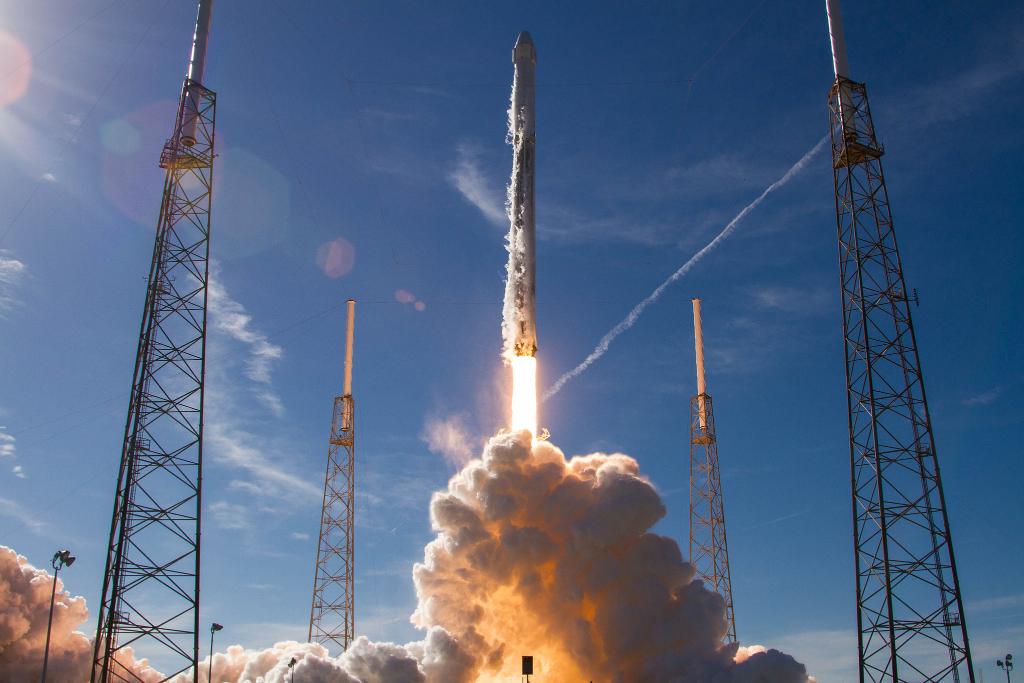It’s been a busy time for Elon Musk and SpaceX, lately. Earlier this week, the company launched 64 satellites (and a art project known as the Orbital Reflector) in what was the largest rideshare mission in history. The mission was also historic because it involved a booster making its third successful landing. And this was after Musk released more details about his proposed BFR, henceforth known as the “Starship”
And earlier today (Wednesday Dec. 5th), SpaceX launched its sixteenth Commercial Resupply Services mission (CRS-16) to the International Space Station (ISS). While the deployment of the Dragon spacecraft was successful, the first stage booster did not make it back to the landing pad. After suffering from an apparent malfunction in one of its grid fins, the booster fell into the sea – but remained intact and will be retrieved.
The mission lifted off at 10:16 am PST (01:16 p.m. EST), from Space Launch Complex 40 (SLC-40) at Cape Canaveral Air Force Station. The Dragon spacecraft, which had previously been used for the CRS-10 mission in February of 2017, carried more than 2,540 kg (5,600 lbs) of supplies and payloads. Among these were materials that are critical to supporting the ongoing research and investigations aboard the ISS.
Liftoff! https://t.co/gtC39uBC7z pic.twitter.com/9Cdjn6yozf
— SpaceX (@SpaceX) December 5, 2018
As with previous launches, the company began live-streaming the launch via webcast. About seven minutes after liftoff, the second stage and Dragon spacecraft separated from the Falcon 9’s first stage and proceeded to Low Earth Orbit (LEO). At 10:26 am PST (01:26 pm EST), SpaceX announced “Second stage engine burn complete. Dragon confirmed in good orbit,” followed shortly thereafter by confirmation that its solar arrays had deployed.
The first stage then began descending towards Landing Zone 1 (LZ-1) at Cape Canaveral Air Force Station. This was to be the twenty-seventh time that SpaceX had managed to successfully retrieve a first stage booster. However, 7 minutes and 25 seconds after the launch, the first stage began tumbling uncontrollably towards the surface. This was apparently due to the failure of one of the grid fins, which stabilize the first stage during its descent.
Luckily, the mission controllers were able to stabilize the rocket in time with some bursts from the engine, bringing the first stage in for a soft landing on water off the coast of Florida. At 10:34 am PST (0:34 EST), Musk tweeted the apparent cause of the failed landing and addressed possible changes to avoid similar problems in the future.
“Grid fin hydraulic pump stalled, so Falcon landed just out to sea. Appears to be undamaged & is transmitting data. Recovery ship dispatched.” he said, adding later, “Pump is single string. Some landing systems are not redundant, as landing is considered ground safety critical, but not mission critical. Given this event, we will likely add a backup pump & lines.”
Engines stabilized rocket spin just in time, enabling an intact landing in water! Ships en route to rescue Falcon. pic.twitter.com/O3h8eCgGJ7
— Elon Musk (@elonmusk) December 5, 2018
Musk also posted the video of the first stage’s descent, which showed it spinning as it fell to Earth, how its spin rate was slowly arrested with correctional thrusts, and how it touched down on the ocean and fell sideways into the water. Musk also indicated that ships were en route to retrieve the booster. When asked if the booster would be reused, Musk replied, “We may use it for an internal SpaceX mission.”
While the first stage booster did not land as intended, the fact that it survived the descent is no small feat. In addition, this should not distract from the fact that the launch itself went by the numbers. Currently, the Dragon spacecraft is on schedule to arrive at the ISS by Saturday, Dec. 8th. Once there, the crew will use the station’s 17.6 m (57.7 ft) robotic arm (aka. Canadarm2) to capture the Dragon spacecraft and attach it to the orbiting laboratory.
The arrival of the Dragon spacecraft will also be the subject of a live webcast. Coverage will begin at about 02:00 a.m. PST (0:500 a.m. EST) with the capture expected to happen about 1 hour later.
In the meantime, you catch the replay of the launch here:
Further Reading: SpaceX, Twitter, ArsTechnica


Was this a Block 5 booster?
Yes. All boosters starting a few months ago are block 5. Block 4 is retired. also it was a new Block 5 booster. SpaceX has only ever used new boosters for Space Station missions (however the Dragon capsule has been reused)..